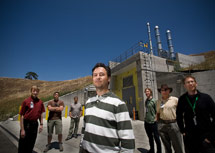
Handy Links
SLAC News Center
SLAC Today
- Subscribe
- Archives: Feb 2006-May 20, 2011
- Archives: May 23, 2011 and later
- Submit Feedback or Story Ideas
- About SLAC Today
SLAC News
Lab News
- Interactions
- Lightsources.org
- ILC NewsLine
- Int'l Science Grid This Week
- Fermilab Today
- Berkeley Lab News
- @brookhaven TODAY
- DOE Pulse
- CERN Courier
- DESY inForm
- US / LHC
SLAC Links
- Emergency
- Safety
- Policy Repository
- Site Entry Form

- Site Maps
- M & O Review
- Computing Status & Calendar
- SLAC Colloquium
- SLACspeak
- SLACspace
- SLAC Logo
- Café Menu
- Flea Market
- Web E-mail
- Marguerite Shuttle
- Discount Commuter Passes
-
Award Reporting Form
- SPIRES
- SciDoc
- Activity Groups
- Library
Stanford
Around the Bay
Where the LCLS Ends: The CXI Instrument
The Coherent X-ray Imaging instrument, the fourth scientific instrument to be installed at the Linac Coherent Light Source, will view single objects smaller than a micron, or one millionth of a meter—tiny. But even better than that, it may be the first X-ray instrument ever to do so for individual biological molecules when it comes online in 2011.
"Synchrotrons like the Stanford Synchrotron Radiation Lightsource are wonderful for imaging biomolecules that can be crystallized," said CXI Instrument Scientist Sebastien Boutet. "With the CXI instrument, we can hopefully for the first time use X-rays to view what can't be crystallized: individual biomolecules."
When researchers send synchrotron X-rays at a crystallized sample, the crystal's repeated molecular structure diffracts the X-rays in a regular pattern. This pattern can be sensed by detectors and analyzed to determine the sample's three-dimensional structure.
Unlike the beams from synchrotron sources, X-rays from the LCLS arrive at an instrument in extremely short and intense pulses that can resolve the structure of single molecules or small clusters. No repeated crystal structure is needed to amplify the signal.
Researchers can't put single, non-crystallized biological molecules in a synchrotron beam for another reason: the beam destroys the sample before sufficient signal can be measured. As X-rays travel through the sample, they knock electrons out of atoms, breaking important chemical bonds and modifying the structure of the sample during the measurement. Synchrotrons avoid this problem by spreading the power of the beam across billions of molecules, reducing the number of electrons expelled from each molecule.
The CXI instrument will solve this conundrum in another way.
"There's a delay between when the X-rays knock out the electrons and when the ions, which are much heavier than electrons, react to one another," Boutet said. "To the first order, X-rays travel at the speed of light while ions repel at the speed of sound."
The CXI instrument can use this delay to its advantage thanks to the structure of the LCLS beam, which is not a continuous stream of X-rays but a series of short, staccato pulses. Each pulse is so short that it can pass through the sample before the sample is destroyed. Having gathered structural information by interacting with the sample before any damage took place, the X-rays carry their intel to waiting detectors.
In this way the CXI instrument may, for the first time, reveal the atomic structure of biological samples that don't crystallize.
"The CXI instrument could have huge medical and technological consequences," Boutet said. "In medicine, it's common for researchers to figure out how diseases work by looking at the structure of the molecules involved. From there, they can figure out how to best attack these diseases."
"Soon, we'll be able to look at the structures of samples never before seen," he added. "LCLS is the ultimate microscope."
This story is the fourth in a series exploring the scientific instruments of the LCLS. See also "The AMO Instrument," "The XPP Instrument" and "The XCS Instrument."
—Kelen Tuttle
SLAC Today, May 26, 200909
